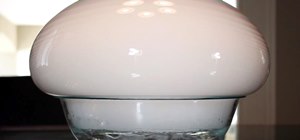Watch this instructional science video to observe the Barus effect in action. A dyed solution of POLYOX (polyethylene oxide - it is the stuff used as the lubricant on the strip found in all modern razors) is extruded from a 50 mL syringe. On exit, a marked swelling in the liquid stream several times the diameter of the orifice is observed. The effect is referred to as the Barus Effect, but it also goes by several other names including the Merrington Effect, Die Swell, and Extrudate Swell.
Polyox is an example of a highly viscoelastic non-Newtonian fluid. The Barus effect is common in highly elastic fluids such as polymer solutions and melts. Water on the other hand, being non-elastic, does not exhibit the Barus effect.
The Barus effect is an example of a so-called "elastic memory" effect. When a viscoelastic fluid is extruded, tensile stresses associated with the extrusion process cause at the microscopic level the long molecular chains of the fluid to stretch before relaxing again on exiting the orifice. The lateral expansion in the liquid results in a corresponding contraction in the liquid stream along the longitudinal direction.
Just updated your iPhone? You'll find new emoji, enhanced security, podcast transcripts, Apple Cash virtual numbers, and other useful features. There are even new additions hidden within Safari. Find out what's new and changed on your iPhone with the iOS 17.4 update.
























Be the First to Comment
Share Your Thoughts